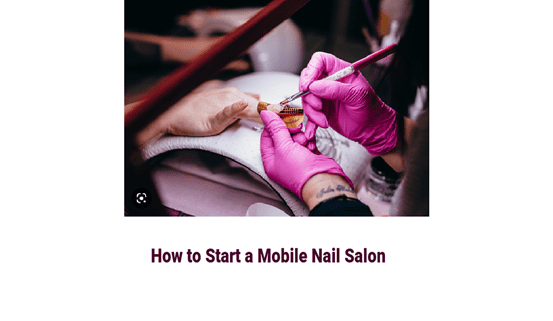How To Start a Graphic Design Business – Easy Steps

Hey there,
If you were wondering,
How to Start a Graphic Design Business?
You are in the right place.
Whether you have been working as a Graphic designer for years or are just starting, there are essential steps to take before beginning. This blog post will review the basics of setting up and marketing a successful graphic design business while providing tips for success. It’s time to get started – let’s go.
What Is a Graphic Design Business?
What Is a Graphic Design Business? A graphic design business is a company that specializes in creating visual content for clients. This can include things like logos, websites, brochures, and packaging. Graphic designers use a combination of typography, color, and imagery to communicate a message or tell a story. They work with various mediums, such as print, digital, and video.
Unlocking the potential of your graphic design dreams is possible when you start a business devoted to it. It can be hard work, but determination and creativity will make all the effort worth it in the end. Crafting designs that bring ideas to life while working with different clients – what could possibly be better?
To get started on this venture, having an excellent portfolio and becoming fluent in popular design software like Adobe Photoshop and Illustrator is essential. You’ll also need impressive marketing skills alongside solid communication abilities so that client relations are always professional and productive.
It’s a good idea to start small, maybe taking on a few small projects to build up your portfolio and gain experience before taking on more prominent clients. And remember, no matter how much experience you have, there’s always something new to learn in graphic design. So, keep learning, stay creative and, most importantly, enjoy the process!
Graphic Design Business Made Easy: a Step-by-step Guide
Establishing a Graphic Design Business doesn’t have to be arduous – adhere to this simple guide. You don’t need substantial funds either; you need your laptop and internet access, and you’ll be ready to go.
As soon as you acquire supplemental income, carry on with the extra steps essential for success. If these straightforward tips remain in consideration, becoming an accomplished Graphic Design is attainable.
1 -Develop Your Skills
This means having a solid understanding of design software and techniques. As a graphic designer, you’ll likely regularly use programs like Adobe Photoshop, Illustrator, and InDesign. It’s essential to have an excellent working knowledge of these programs and other design software that may be relevant to your niche.
Additionally, staying current with design trends and techniques would be best. This could mean taking classes or workshops, reading design blogs and publications, or experimenting with new software and technologies. The more you know and understand the design industry, the better equipped you’ll be to offer high-quality services to your clients.
Not only that, it’s essential to understand design principles like typography, composition, color theory, and visual hierarchy. It’s also necessary to understand the design process, from concept development to final production.
Another critical skill is understanding how to communicate with clients. You’ll need to be able to understand their needs and goals and then translate that into a visual language that effectively communicates their message. Strong communication skills will help you to build trust with your clients and to ensure that you’re meeting their needs.
In short, developing your skills is crucial for a graphic design business; it’s important to have an excellent working knowledge of software, stay current with design trends and techniques, and have good communication skills. It will help you to offer high-quality services to your clients.
2 –Build a Portfolio of Your Work
Having an impressive portfolio is essential for gaining the attention of potential customers’ attention and furthering your career. Select only your finest projects that exhibit who you are and what you do – then display them in a captivating way to make sure they stand out!
Make sure your portfolio is easy to navigate, with high-quality visuals that showcase the full range of your design projects–from logos and brochures to websites and packaging. Whether you create a website for it, print out books, or offer PDFs – ensure viewers can explore without difficulty.
When you showcase each project, include helpful details such as the team members involved, their mission for the task, and how it came to fruition. Furthermore, keep your portfolio up-to-speed by frequently adding new projects demonstrating your current abilities and presenting potential clients with better insight into your recent works.
3 –Determine Your Niche
A niche is a specific area of expertise or market you focus on. Identifying your niche will help you to narrow down your target market and to differentiate yourself from other designers. It will also help you to create a more focused and effective marketing strategy.
When determining your niche, it’s essential to consider your skills, interests, and experience. For example, if you have a background in marketing, you may want to focus on creating designs for marketing materials. Or, if you have experience in packaging design, you may want to focus on that area.
As you embark on the journey of taking your business public, it is paramount that you conduct thorough research to identify who your primary target audience is and craft services tailored specifically to their requirements.
Understanding what potential buyers are searching for when they contact your platforms will ensure tremendous success in a competitive market.
Capturing potential customers means ensuring that your specific services are accurately displayed on your marketing materials.
This way, those seeking design solutions like yours can quickly understand what makes you exceptional and determine if it suits their requirements. Presenting yourself in the right light is essential for converting leads into clients.
4 –Research the Market
Studying your market’s trends is a must to stay up-to-date with the competition and pinpoint potential clients. Perform research on local and national competitors to take note of their services, pricing practices, and marketing tactics.
Doing so will empower you to position your business strategically in this dynamic industry. To ensure market success, it is wise to evaluate the competition and recognize any existing gaps in the industry you can fulfill.
Additionally, aim your research towards local companies or organizations that may require graphic design services—it could prove profitable! Further, develop potential client relationships by networking with other professionals within this field; these connections might lead to remarkable opportunities.
After thoroughly analyzing your target market and competitors, utilize the findings to create a marketing plan that caters to their needs while distinguishing you from other businesses.
5 –Create a Business Plan
A business plan is a critical document for any entrepreneur. It outlines the objectives, techniques, and methods that help to keep your venture on course as it expands. When assembling yours, make sure you have included these key components:
An executive summary: Here, we will offer a concise synopsis of your organization’s ambition, objectives, and mission.
A market analysis: To gain a competitive edge, you must understand your target market, competitors, and industry trends. This section will provide the necessary details to help inform your decisions.
A description of your products or services: Make sure to provide an in-depth explanation of what services you’ll offer and how they will fulfill the requirements of your intended demographic.
A marketing and sales strategy: This section should contain methods to market your business and attract new customers.
An operations plan: This section should provide a comprehensive overview of the operational functions within your business, including information about management structure, location, and necessary equipment. Having this in place, you can ensure that day-to-day operations run as smoothly as possible.
Financial projections: This part of your business plan should include an overview of anticipated income and expenditures and a break-even analysis. Always remember that this plan is fluid — it’s imperative to update it as your venture evolves continually. Constant review and refinement of your business plan will keep you on the path to success and enable you to make any necessary modifications.
6 –Choose a Business Name
Crafting the perfect business name is essential for your branding, as it will be one of the first things prospective customers notice. For a memorable and impactful name that accurately represents your services, take into account these vital criteria:
Make it memorable: Make your mark and pick a name that is easily recalled while you set yourself apart from the competition.
Make it relevant: Your business name should accurately reflect your services and the audience you are trying to reach.
Make it unique: Make sure your business name does not inadvertently mimic any other existing companies in the area. Creating a unique and distinct brand for yourself is best, so be sure to create an original title.
Make it easy to spell and pronounce: To help your customers easily find you, select a simple name to spell and pronounce with ease.
After you settle on a proper name, it’s essential to make sure that the domain is available and hasn’t been trademarked by someone else. For this purpose, you can use websites like GoDaddy for domain availability check-ups and the USPTO website for trademark searches. To ensure maximum impact on your business identity, once chosen, be sure to keep consistency across all marketing materials, such as webpages, brochures, or even business cards.
7 –Register Your Business
When launching your business, it’s essential to register with the state government by selecting a suitable structure such as sole proprietorship, partnership, LLC, or corporation. Each choice has its unique benefits and drawbacks; therefore, you must conduct diligent research to decide which one suits your goals best.
Subsequently, any required licenses or permits must be obtained to operate legally. This might include business licenses, sales tax licenses, and city or county-specific permits. You may also need to register for extra licenses based on the kind of business you own or where it is located.
It’s essential to take care of the legalities when it comes to employing individuals, which is why you must be sure that your company adheres to all state labor laws, such as employee classifications, wages, and hours. Additionally, ensure not to forget any renewal requirements for licenses and permits. Be proactive in regularly visiting your state government website to stay informed on all necessary renewals.
8 –Set Your Pricing
To make sure your business succeeds, you must price your services correctly. It would be best to find a balance between charging what is necessary for covering expenses and making a profit without pricing yourself out of the market. As you determine how much to set, take into consideration these key elements:
Your costs: When running a business, you must consider your expenses – from materials and software to the equipment needed for everyday operations.
Your competition: Compare the rates of other designers in your local area to ensure your prices are up-to-date and competitive.
Your expertise: Leverage your knowledge and advanced skill set to charge above the market rate – you deserve it! With more experience than those around you, why not capitalize on your hard-earned knowledge? This will increase your profits while also allowing others in need of quality services access to someone like yourself.
Your target market: Strategically consider your target audience’s earning capacity and budget while deciding on a price point.
Transparency with your pricing is critical to ensure clients know what they’re paying for. You can list the cost on your website or portfolio and offer it upon request. As you continue to build up your business and expenses, fluctuate, regularly looking at how much you charge may be necessary to stay competitive yet profitable.
9 –Create a Website
Having an online presence for your business is indispensable. It showcases your portfolio to potential clients and provides them with necessary information about you and your services. As such, it’s vital that when crafting a website, one should take into consideration the following aspects:
User experience: Guarantee that your website is straightforward to navigate and comprehend, so users can easily find the information they need.
Design: Your website should reflect your unique style and be synonymous with your branding.
Content: When constructing your website, it’s crucial to include details about your business–such as the services you offer, a portfolio of past work, and contact information. Doing so enables customers to easily find out what they need to know to make decisions that benefit them.
SEO: If you want more people to find your website, ensure it is optimized for search engines. This will ensure your site’s visibility on the top pages of search engine results.
There are many options available for creating a website, such as website builders like Wix, Squarespace, or WordPress, or you can hire a web developer. If you are unfamiliar with web development, using website builders will be much easier and less expensive.
It’s important to remember that your website is often the first point of contact between you and a potential client, so it’s essential to make an excellent first impression.
10 –Establish a Social Media Presence
Social media is a powerful tool for promoting your business and connecting with potential clients. It allows you to share your work, engage with your audience, and build relationships with potential clients.
When establishing your social media presence, consider the following:
Choose the right platforms: Not all social media platforms will be relevant to your business, so choose the ones on which your target market is most active.
Consistency: maintain a consistent voice and aesthetic across your social media platforms.
Engagement: Engage with your followers by responding to comments and messages and sharing valuable content.
Promotion: Use social media to promote your business by sharing your portfolio and upcoming projects.
Some popular platforms for graphic designers include Instagram, Behance, Dribbble, and Pinterest, where you can share your work, connect with other designers and showcase your portfolio to a broader audience.
Remember that social media is a long-term strategy; it takes time to build a following. Consistency, engagement, and promotion are vital to making it effective.
11 –Network with Other Professionals
Networking is vital in building relationships and finding new clients in the industry. It can also be a great way to learn from others, stay current with industry trends, and gain access to new tools and resources.
When networking, consider the following:
Attend industry events: Attend conferences, workshops, and meetups to connect with other professionals in your field.
Join professional organizations: Many organizations have local chapters that hold regular meetings where you can connect with other members and learn about industry trends and opportunities.
Reach out to other designers: Connect with other designers through social media, email or in person to build relationships and learn from one another.
Be open to collaborations: Collaborating with other designers can be a great way to build relationships and expand your portfolio.
It’s important to remember that networking is about finding new clients and building relationships with other professionals in your field. These relationships can be a valuable resource for learning, mentorship, and finding new opportunities.
12 –Create a Contract
A contract is a legally binding agreement between you and your client that outlines the scope of work, payment terms, and other details related to the project. Having a contract in place will help to protect both you and your client and ensure that the project runs smoothly.
When creating a contract, consider the following:
Include a clear scope of work: This should include a detailed description of the work, including any deliverables and deadlines.
Include payment terms: This should include the total cost of the project, the payment schedule, and any details about the payment process.
Include information about revisions: This should include the number of revisions in the contract and any additional fees for extra modifications.
Include copyright information: This should include who owns the rights to the final designs and any usage rights granted to the client.
Include a termination clause: This should include the conditions under which either party can terminate the contract.
Having your contract reviewed by a lawyer is also essential to ensure that it is legally binding and meets all your state’s requirements.
13 –Get Insured
Insurance is an effective way to protect your business and yourself from costly financial losses. As a graphic designer, you may require different types of insurance, such as general liability, professional liability, or even business interruption coverage. With the right insurance policy in place, you can be sure that all your bases are covered whenever any unexpected event occurs.
With general liability insurance, your business is shielded from financial harm should legal action arise due to damages caused by you or an employee. Whether the claim be for bodily injury or property destruction, this type of policy can provide a much-needed layer of protection against an outside force.
Prevent potential financial disasters with professional liability insurance, known as errors and omissions coverage. Without it, you could face expensive legal costs if a mistake or oversight in your work causes someone to sue you. Business interruption protection ensures that when natural disasters disable your business operations, the resulting economic losses won’t bankrupt your company.
When selecting an insurance policy for your small business, you must reach out to a reputable broker or agent specializing in such matters. They will provide you with a comprehensive review of the available options but also help guide you toward what best suits your needs.
Regularly take the time to assess your insurance policies and ensure that they satisfy all of your current needs. It’s essential to meticulously read every aspect, including coverage limits, exceptions, and deductibles. As you continue to expand and progress in business, there will likely be shifts in what kind of coverage you require. Remember to review these documents on an ongoing basis for extra security.
14 –Set up a Financial System
Establishing a financial system is vital if you want to monitor your cash flow, and track expenses and taxes in an organized manner. But before you get started, make sure to consider these key elements:
Separate your personal and business finances: Creating a separate business entity will not only simplify the tracking of your income and expenditures, but it’ll also serve to safeguard your possessions.
Choose accounting software: If you’re seeking to track your receipts and payments while also generating financial reports, then look no further than accounting software options like QuickBooks, Xero, or Wave. These reliable and user-friendly platforms make them the perfect choice for keeping tabs on your finances!
Set up a system for invoicing and collecting payments: You could get your business off the ground by leveraging a digital payment platform, such as PayPal or Stripe, and invoicing software, like Freshbooks or Zoho Invoice.
Plan for taxes: To ensure your business runs smoothly and fulfills your tax obligations, talking with a tax specialist is essential. With their assistance, you can form an efficient plan for tracking income, expenditures, and taxes – all crucial elements for the success of any organization! Additionally, through meticulous record-keeping, you’ll be able to base decisions regarding financial matters on well-informed judgments.
15 –Build a Team
Establishing a team of employees, freelancers, interns, or contractors (depending on your business) is key to expanding your venture and realizing more projects and increased income. As you create this team, it’s imperative to consider the following points:
Assess your needs: Analyze what capabilities and knowledge you need to develop your business and the positions that must be filled.
Hire the right people: When searching for the best fit for your team, ensure that you are looking at candidates with appropriate skills and backgrounds to fill each position. It is essential to conduct comprehensive interviews and check references before bringing someone on board.
Create a positive working environment: Create a positive, collaborative atmosphere in the workplace by setting clear expectations, staying connected with your team, and investing in their professional growth.
Establish clear roles and responsibilities: All team members should know their roles and responsibilities to operate efficiently together. Building a successful team may require patience, but it will ultimately prove invaluable for your business development.
16 –Continuously Market Your Business
Nurturing your business, brand, and client base requires effective marketing. This entails targeting potential clients while simultaneously cultivating relationships with your current customers. As you proceed to promote your company, make sure that the following aspects are taken into consideration:
Develop a marketing plan: When crafting your marketing strategy, consider the necessary facets to ensure its success: who is your target market, what are your goals, and how will you reach them? With this blueprint in place, you have taken a significant step toward achieving remarkable results.
Use a variety of marketing channels: Boosting your visibility and engagement with potential customers could involve a mix of social media, email marketing, content creation, networking opportunities, or advertising campaigns.
Measure your results: Monitor and analyze the performance of your marketing strategies, including newly acquired customers or generated profits. Utilize this data to update your approach and ensure maximum returns on investment.
Continuously improve: To secure more customers and stay ahead of your competition, keep up-to-date with the newest marketing trends and tools. Don’t forget that effective marketing isn’t a one-off event; it’s an ongoing journey requiring you to market your business while adapting to changing circumstances persistently.
17 –Continuously Learn and Improve
As a graphic designer, staying up to date with the latest design trends and technologies is essential to provide optimal client service. Keeping on top of emerging best practices while pushing your skillset can be daunting; however, it’s critical to factor in the following:
Stay current with the latest design trends and technologies: To stay ahead of the competition, you must invest in yourself continually. Doing so could include researching new design software, testing innovative design methods, and attending professional workshops or conferences.
Seek feedback and critiques: Requesting feedback from other designers, clients, and industry professionals can open your eyes to areas that require improvement. Additionally, reflect on past projects and examine the obstacles or missteps you encountered; this will provide invaluable learning opportunities.
Continuously improve your portfolio: To stand out from the competition, ensure your portfolio is always up-to-date with your most recent and innovative work. Use it to showcase your talents and technical skills to interested clients. Remember that as a designer in the ever-evolving design industry, you must stay informed of new trends while developing professionally – only then will you remain relevant and competitive!
Conclusion: How to start a Graphic Design Business
Crafting a successful graphic design business often takes time and dedication, but you can make it happen with the right attitude and strategy. Make sure to stay organized and concentrated, and don’t be afraid to get help.
Additionally, keep learning new techniques as the industry is constantly evolving—you must remain up-to-date if you want your business to thrive.
Most importantly, enjoy the process.. Utilizing your enthusiasm for graphic design to initiate a business can be an exhilarating experience. When approached correctly, you could transform this passion into a rewarding career.
SickofTheBoss.com is the brainchild of Jack Bastide. It is designed for entrepreneurs and those that want to be. You can find Jack on Facebook or Linked






